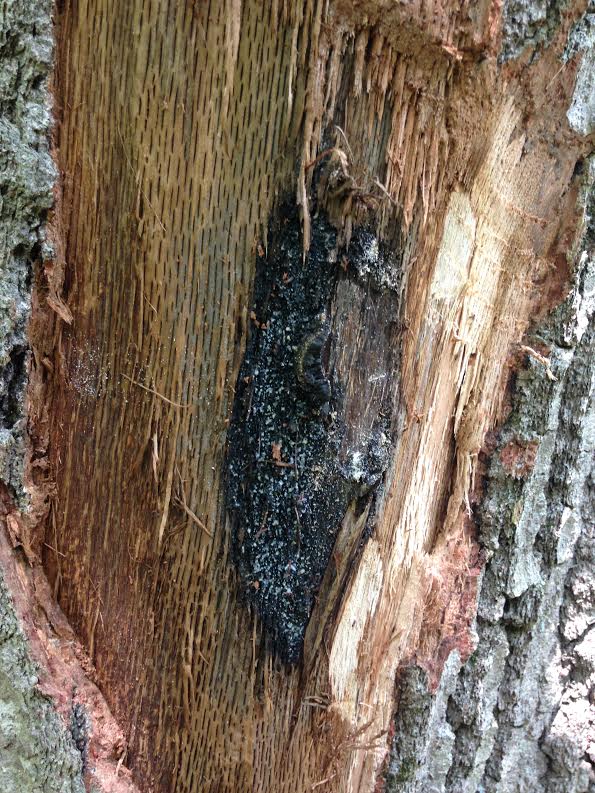Invasive species pose economic, social and environmental threats and negative impacts. For example, USDA-APHIS (2000) reported that the chestnut blight disease basically eliminated American chestnut from eastern forests, destroying wildlife habitat and decreasing the value of this species for timber. The European gypsy moth, which is currently found in nineteen states, has caused more than $3.9 billion in tree losses. This page provides information and links to resources on some of the known economic, social and environmental impacts of invasive organisms in Michigan and nationwide.

Economic and Social Impacts
A Brief Look into Michigan’s Economy and the Effects of Invasive Species Highlights how invasive species impact the use and beauty of Michigan’s trails, parks, shorelines, native fisheries and wildlife, agricultural and forestry industries.
What We've Lost. Discuses the community and public costs impacts of invasive species.
The True Cost of Invasive Species Elucidates the economic impacts of invasive species, including Emerald Ash Borer
Cost of Potential Emerald Ash Borer Damage in U.S Communities, 2009-2019 Estimated the discounted cost of ash treatment, removal, and replacement on developed land within communities in Detroit using simulations of EAB spread and infestation over the next decade (2009-2019). Found an estimated $38 million ash trees on this land base.
The Dynamic Response of Housing Values to a Forest Invasive Species: Evidence from a Sudden Oak Death Infestation Estimated how residential property values in Marin County, California, was affected by Sudden Oak Death (SOD) infestation. Reported the most severe discounted effect of 8–15% on properties and that the effect can last for several years.
The Economics of Invasive Species This report by Oregon Sea Grant discusses the economic impacts of some selected invasive species in Oregon and US.
Economic Impact of Invasive Species Presents an economic analysis of the actual damages and potential impacts on Washington economy that could result from 23 invasive species. This analysis covers the economic costs of invasive species in lost jobs, lost wages, and lost business sales.
Economic Impacts of Invasive Species in the Pacific Northwest Region Elaborates some ways in which invasive species are posing economic burden to the region.
Annual Losses to Great Lakes Region by Ship-borne Invasive Species at least $200 Million A factsheet that presents preliminary results of the economic impacts of ship-born invasive species to the Great Lakes region.
Update on the Environmental and Economic Costs Associated with Alien-invasive Species in the United States Is a study which estimated the economic cost in the US from alien invasive species as $120 billion/year.
Economic Impacts of Invasive Species in Forest Past, Present, and Future (2009) USDA Discuses and proposes a market and nonmarket-oriented methods for evaluating the economic damages from forest-invasive species.
Impacts of Nonnative Invasive Species on US Forests and Recommendations for Policy and Management Provides an overview of the impacts of NNIS on sustainability, forest managements, within the United States and includes recommendations for NNIS policy and management.
Economic Impacts of Non-Native Forest Insects in the Continental United States An interesting study that models the economic impacts of invasive species. Suggests that wood- and phloem-boring insects uch as the emerald ash borer and the Asian longhorned beetle can cause about $1.7 billion annually in local government expenditures and approximately $830 million in lost residential property values yearly.
Environmental and Economic Costs of Nonindigenous Species in the United State Assesses the environmental impacts and economic costs associated with some invasive species in the United States.
The Actual and Potential Economic Impact of Invasive Species Offers a preliminary assessment of invasive species can affect a park economy.
Invasive Species Definition Clarification and Guidance White Paper This white paper discuses the human, environmental, ecological and other impacts posed by invasive species.
Ecological and Environmental Impacts
Invasive Species: How They Affect the Environment Elaborately sheds insights on the environmental consequences of invasive species and what can be done to deter them. The page features a comprehensive listing of resources on invasive species.
Invasive Forest Defoliator Contributes to the Impending Downward Trend of Oak Dominance in Eastern North America This study suggests that Gypsy moth outbreaks is contributing to the continued declines in young oak age classes in the region.
Ecological Impacts of Emerald Ash Borer in Forests at the Epicenter of the Invasion in North America This study suggests that the ecological impacts of EAB had overreaching impacts on forest communities, including successional trajectories, growth of non-native invasive plants, soil dwelling, and herbivorous arthropod communities, and bird foraging behavior, abundance, and community composition.
Great Lakes Under Stress: Invasive Species as Agents of Ecosystem Change Offers a dense exploratory overview of how invasive species have been disrupting the natural ecosystem behavior and function in the Laurentian Great Lakes of North America, focusing specifically on Lake Erie and Lake Ontario.
A Review of Impacts by Invasive Exotic Plants on Forest Ecosystem Services Presents a literature review on the potential impacts of Kentucky's most invasive exotic plant species on natural and semi-natural systems. The review suggests that many of the species can alter ecosystem processes and functions.
Impacts of Invasive Species on Ecosystem Services This book chapter discusses how invasive species affects community dynamics, ecosystem processes and ecosystem services.
Chronic Impacts of Invasive Herbivores on a Foundational Forest Species: A Whole‐tree Perspective Report the results of a 4‐yr field experiment addressing the individual and combined impacts hemlock woolly adelgid (Adelges tsugae) and elongate hemlock scale (Fiorinia externa), on native eastern hemlock (Tsuga canadensis) in southern New England.



 Print
Print Email
Email